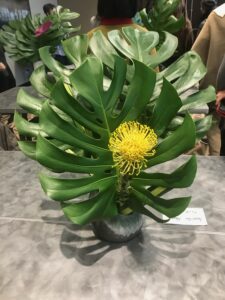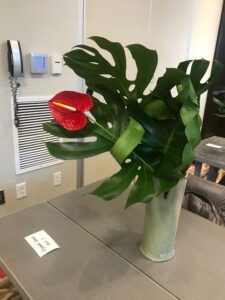Figure and ground
In a formal art education, Students are introduced to formal concepts. Things such as color, line, composition, etc. Some of these individual things are talked about in our current Ikebana curriculum. For example color, line, mass.
Kawana-Sensei wanted to introduce a new element to the standard curriculum. This new addition is an extension of composition. In a typical art curriculum composition is an understanding of how the human eye perceives the world. What we focus on and how our eye moves through a variety of different visual inputs. Using this information we, as artists, can make better creations.
The specific area that he wants us to look at is foreground and background. He uses the word form to mean the subject of the art. Whether that be an apple in a painting or a person drinking tea. He is using the word ground to refer to background, in most cases maybe scenery.
The goal of this lesson was for each and everyone of us to create a background for our flower, which was to be our focus or figure. When you make a background you need to be conscious to make sure that it’s not too interesting in and of itself. You want to have a background that does not overpower, or take away any of your visual input away from your focus.
I think the goal of this lesson is to remind us as designers to take in the context of which we are putting our arrangements. Not only do we have to look at the context of the vase and it’s color, but also the wall in which is going to be in front of, or the painting which may be behind it. We need to be aware of the lighting and the atmosphere in which the arrangement is been placed. When the background takes away from our creation, we can make our own using plant material.


Main critiques
- Making the background too interesting.
- Not creating a background with volume. Related to this is forgetting to make it three dimensional.
- Try to make the background seem to extend the arrangement by Cutting the leaves over the top of the vase, leaving the flowers back in general making the leaves or background feel bigger than it truly actually is.
- Non optimal flower placement. The goal is to have the flower be the center of attention and for the background to be just that background.
Discussion
When did up having a discussion about leaf manipulation. When does manipulation transform the fundamental energy of a natural material?
There really is not a specific answer. When we honor the fundamental energy of a plant material, there is a point at which we change that nature to something more artificial. Each artist is having a continual negotiation between the plant material and the arrangement they’re making.
